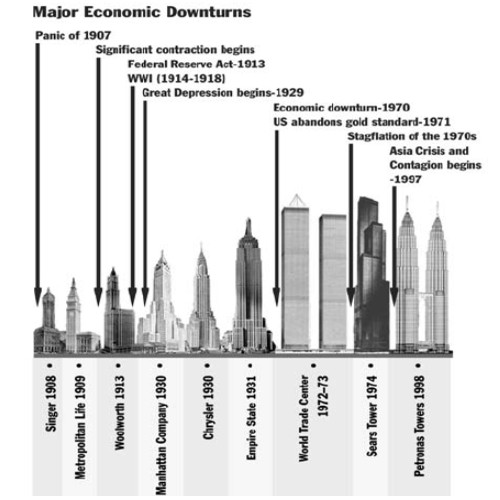
By Catherine Cashmore, a market analyst, journalist, and policy thinker, with extensive industry experience in all aspects relating to property. Follow Catherine on Twitter or via her Blog.
“Bill, how high can you make it so that it won’t fall down?” reportedly asked financier John J. Raskob, as he pulled out a thick pencil from his draw, and held it up to William F. Lamb, the architect he had employed to design and construct The Empire State Building.
It was the ‘race for the skies’ and it marked the peak of the roaring Twenties. Capturing what is perhaps one of the most exciting periods in New York’s history.
“Never before have such fortunes been made overnight by so many people,” said American journalist and Statesman Edwin LeFevre (1871–1943)
While areas of the economy such as agriculture and farming, were still struggling to gain ground from the post WWI depression, and a large proportion of the population continued to live in relative poverty. Advances in technology, rapid urbanisation and mass advertising accelerating consumer demand, produced an era of such sustained economic prosperity, it led Irving Fischer, one of America’s ‘greatest mathematical economists’ to famously conclude that,
“Stock prices have reached what looks like a permanently high plateau.”
“… Only the hardiest spoilsports rose to protest that the wild and unchecked speculative fever might be bad for the country..”
Wrote historian Paul Sann, in his publication, ‘The Lawless decade.’
“The money lay in stacks in Wall Street, waiting to be picked up. You had to be an awful deadhead not to go get some.”
Land values of course captured the gains, and between 1921 and 1929 lending on real estate increased by 179%, and urban prices more than doubled.
According to research collated by Professor Tom Nicholas and Anna Scherbina at the Harvard Business School in Boston, by 1930 values in Manhattan, including the total value of building plans, contained “only slightly less than 10% of the total for 310 United States cities (Manhattan included) during the same period.”
A staggering figure considering Manhattan at the time contained only 1.5% of the US population.
Few raised concerns however.
It was believed the Federal Reserve Act, created in 1913 “to furnish an elastic currency” would tame the business cycle and – as the First Chairman of the Federal Reserve Charles S Hamlin put it,
“..relegate to its proper place, the museum of antiquities – the panic generated by distrust in our banking system..”
The National bank runs of the past had been exacerbated because there was ‘no stretch’ in times of crisis, or moderation in the rates of interest.
However, the bulk of lending against real estate over this period was not limited to New York, or to institutions that were members of the Federal Reserve.
Thousands of new banks were setting themselves up in outlying areas and, as Elmus Wicker, author of ‘The Banking Panics of the Great Depression’ writes:
“..(they) were either operated by real estate promoters or exhibited excess enthusiasm to finance a local real estate boom”
It brought with it a period of high inflation, and coupled with speculation in real estate securities, produced an explosion in the value of construction that would not be equalled until the boom bust era of the late 1980s.
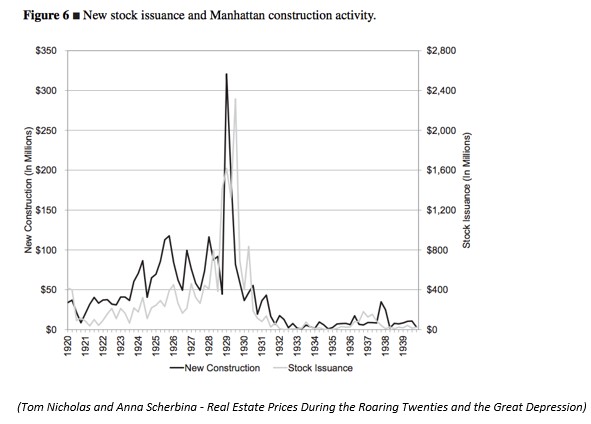
By 1925 real estate bond issues, accounted for almost one quarter of all the corporate debt supplied – and between 1925 and 1929 alone, a quarter of New York’s financial district was rebuilt and 17,000,000 square feet of new office-space added.
This, prompted the owners of the grand Waldorf-Astoria Hotel at 34th Street and Fifth Avenue to sell.
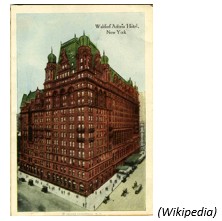
Arising from a family feud between two competing cousins, the iconic guesthouse had been built at the top of a preceding boom bust land cycle in the early 1890’s, and, as ‘the most luxurious hotel in the world,’ stood 17 stories high towering above the surrounding residences.
By the late 1920s however, the décor had become dated, and the social elite had centred its self much further north.
The owner’s decision to upgrade into the Park Avenue district, and build what was then, ‘the tallest hotel in the world,’ allowed John Raskob to acquire the site for his Empire State Building, for the not so small sum of $16 million.
Raskob needed a further $50 million for construction, which he achieved with a $27.5 million dollar mortgage, as well as engaging with a limited number of substantial backers.
“If the amounts seem considerable the backers knew that this was a money maker. The building would be the greatest showcase in the city filled with them. And tenants would line up to print “Empire State Building” on their letterhead….” wrote Robert A. Slayton author of Empire Statesman: The Rise and Redemption of Al Smith
The location was later criticised for being too far from public transport, but no such concerns were raised at the time.
New York office leases began on May 1st – the sooner the building was completed, the sooner it would bring in an income and notwithstanding, Raskob’s two main competitors also in the race for height supremacy – Auto industry giant Walter Chrysler and investment banker George Ohrstrom – had already started.
Chrysler had seized his opportunity when gratuitous plans for an opulent office block designed by architect William Van Alen, had fallen through due to financing.
He took over the project with clear intentions.
Adjusting the tower’s ascetics to reflect the company’s triumphs, with gargoyles, eagles and corner ornaments made to look like the brand’s 1929 radiator caps. Chrysler instructed the builders to make sure his toilet was ‘the highest in Manhattan’ so he could look down, and as one observer put it, “shit on Henry Ford and the rest of the world.”
Around the same time, George Ohrstrom, also determined to set the record, purchased the site that was to become the headquarters of The Bank of Manhattan at 40 Wall St.
Ohrstrom’s architect was H. Craig Severance, former partner and competitor to Walter Chrysler’s designer, Van Alen – and the bitter rivalry between the two added considerably to the dynamic.
Construction for 40 Wall start started in May 1929 and no less than one month later, in April of the same year, fearing competition Chrysler reportedly called his architect in frustration exclaiming;
“Van, you’ve just got to get up and do something. It looks as if we’re not going to be the highest after all. Think up something! Your valves need grinding. There’s a knock in you somewhere. Speed up your carburettor. Go to it!” Higher: A Historic Race to the Sky and the Making of a City Neal Bascomb
Van Alen subsequently increased the height of the Chrysler tower to 925-feet, and added more stories – 72 in total.
Not to be outdone however, Severance added 4 extra floors to his own design, extending the building’s height to 927-feet – only marginally taller than Van Alen’s efforts, but by this stage the steel frame for the Chrysler building had already been completed and in Ohrstrom’s mind, he had already won.
The Bank of Manhattan was finished at record speed, taking just 93 days in total -meeting the May 1st deadline, and setting the record for skyscraper construction.
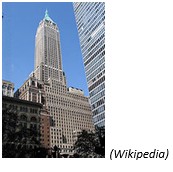
It opened with great celebration – with Ohrstrom boastfully laying claim to the title of ‘the world’s tallest,’ while in blissful ignorance of the final trick Chrysler had yet to pull from his sleeve.
Replacing the original plans of a dome shaped roof, Van Alen enhanced the design with the addition of a 186 foot iconic spire, which was hoisted to the top of the structure in secret, and assembled in a mere 90 minutes.
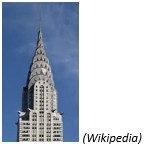
This raised the building’s height to 1,046 feet, a total of 77 floors – allowing Chrysler, less than one month later, to trump Ohrstrom’s record – which ironically, is the name of the building today – ‘Trump Tower!’
The battle continued long after both blocks were completed, with the consulting architects of 40 Wall Street, Shreve & Lamb, writing a newspaper article claiming that their building contained the highest useable floor, and therefore was more deserving of the title.
It was the Empire State Building however, that finally settled the matter.
Hamilton Weber, the original rental manager, takes up the story.
“We thought we would be the tallest at 80 stories. Then the Chrysler went higher, so we lifted the Empire State to 85 stories, but only four feet taller than the Chrysler. Raskob was worried that Walter Chrysler would pull a trick – like hiding a rod in the spire and then sticking it up at the last minute” The Empire State Building Book by Jonathan Goldman
The solution to Raskob’s worries was to add what he quaintly termed “a hat!” – marketed as a mooring mast for dirigibles – although never utilised due to the strong winds and updrafts that circulated at the top.
This raised the building’s height to 1,250 feet, easily outstripping both Chrysler’s and Ohrstrom’s efforts, allowing Raskob to scoop the title.
Taking just 13 months to complete, 58 tons of steel, 60 miles of water pipe, 17 million feet of telephone cable and appliances to burn enough electricity to power the New York city of Albany. The Empire State building with 2.1 million square feet of rentable space opened on May 1st 1931 empty, just as the country was entering one of the worst economic depressions in recorded history.
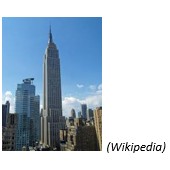
Dubbed ‘The Empty State Building’ – it did not turn over a profit until 1950, putting Raskob, who in 1929 had penned the famous article ‘Everybody Ought to be Rich‘ by investing in “America’s booming corporate economy” deep in the red.
The history of this era is a fascinating study, however as entertaining this story is, it does not stand in isolation.
From long before the Empire State Building was completed, to the most recent example – the Burj Khalifa in Dubai – mankind’s quest to reach the heavens and demonstrate power through the imposing dominance of ‘the world’s tallest’ structure has – with no notable exception – commenced at the peak of each real estate cycle and opened its doors during the bust.
The pattern is easy to follow:
Improvements in the economy are first reflected in rents, which adjust quicker to market conditions than associated expenses – insurance and utility rates for example – which are subject to contract and therefore typically rise out of step.
This in turn attracts speculative investment, pushing prices upwards beyond the cost of replacement, fueling a cyclical rise in construction, which is usually for the purpose of speculation, rather than genuine homebuyer demand.
The steeper land values become, the higher the building must be in order to achieve a profitable return, this in turn increases demand to concentrate both labour and capital around what is usually a centralised core.
There is, however, a lag in the time it takes for high-density construction to reach the market – usually a number of years – before the extra supply can drive down both rents and values, resulting in the building boom outlasting the boom in prices, and an overhang of vacancies when the fervour dissipates.
Notwithstanding, there are limits to how high you can extend, before the whole project becomes unprofitable.
“… floor and wind loads, people, water and supplies must be transferred to and from the ground, so the higher you go, the more of the floor area must be occupied by structural supports, elevators and service ducts. At some point it becomes uneconomical to add additional floors, the diminishing increment of useable floor area, does not justify the additional cost.”
In a subsequent publication he goes one-step further.
“I suspect you would find that going for the title of ‘tallest’ is a pretty good indicator of CEO and corporate hubris. I would look not only at ‘tallest in the world,’ but also more locally—tallest in the nation, the state, or the city. And I’d also watch out for conspicuously tall buildings in locations where the densities and land values do not justify it” ‘Practical Speculation’, By Victor Niederhoffer and Laurel, Kenner
Mitchell’s warning, to look for the “tallest” is not to be taken lightly.
The New York Tribune Building for example, one of the world’s first skyscrapers boasting to be “the highest building on Manhattan Island” – opened in 1874 and coincided with the 1873 financial crisis in both Europe and North America.
The Manhattan Building in Chicago Illinois and the Pulitzer Building in New York, boasting the title of “the world’s tallest” – opened between 1890 and 1891 and coincided with one of the worst economic depressions of that time (particularity in Australia.)
The Singer Building and The Metropolitan Life Insurance Company Tower in New York, boasting the title of ‘the world’s tallest’ – opened in 1908 and 1909 respectively and coincided with stock market panic of 1907 (the Knickerbocker Crisis.)
The World Trade Centre in New York, boasting to be ‘the tallest twin towers in the world’ – opened in 1973 and coincided with the 1973-75 economic recession.
The Sears (or Willis) Tower, boasting to be the ‘tallest in the world,’ opened in May 1973, coinciding once again, with the 1973-75 recession.
The Petronas Towers in Malay – surpassing The World Trade Centre as the ‘the tallest twin towers in the world’ opened its doors to tenants in 1997, coinciding with the Asian financial crisis.
The Taipai 101 in China, the first to exceed half a kilometre, boasting to be ‘the tallest in the world’ opened its doors in the early 2000s, coinciding with the ‘Dot.com’ bubble and burst.
And most recently, the Borj Khlifa in Dubai, the current ‘tallest in the world’ -, opening in 2009, coinciding the sub-prime crisis, estimated to be the worst economic collapse to date.
There are numerous examples, and rarely do these structures go up alone. As we are seeing currently both here and aboard, the rate of high-rise construction across the world, stands at unprecedented levels – funded by low interest rates and a wash of easy credit.
Matthew Guy has been a staunch supporter of higher density dwellings, but risks surrounding a boom on the scale we are witnessing presently, cannot be diminished.
The small one and two bedroom apartments, funded by offshore speculation, are poorly designed, lack natural light, do not offer value for money, and lay out the reach of most first home buyers who face tighter lending restrictions for dwellings of this type.
Notwithstanding, Prosper Australia’s Speculative Vacancies report for Melbourne in 2013, revealed many of these properties sit empty – up to 22% in the Southbank and docklands area – a figure that could well be higher today considering the rate of what can only be termed, ‘bubble’ construction.
And to make matters worst, there is growing evidence the approved sites for skyscraper construction are being ‘flipped’ prior to commencement, with the new owners reapplying to have height limits extended still further.
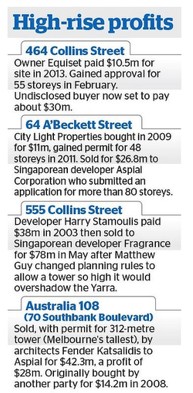
(Developers ‘flipping’ projects for huge profits – The AGE September 1, 2014)
The next ‘world’s tallest’ will be the proposed Azerbaijan Tower, in Baku, due for completion in 2019 – and projected to be 1km high.

It coincides nicely with the completion of ‘the tallest’ residential tower in the Southern Hemisphere – Australia 108 in Melbourne – which at 319 metres tall, will exceed the height of the current record holder – the Eureka Tower – and unless we see changes to current policy – will mark a period of financial instability.

Only by removing the accelerants that produce this behaviour – contained in our tax, supply, regulatory and monetary policies – can we start to address the systemic boom and bust cycles that lay us open to financial crises, fueling the boastful passions of corporate financiers, at the expense of the rest of the population.
Every citizen in Australia would be richer by a significant margin if we collected the economic rents from, land, resources, banking profits, government grated licences and so forth – the ‘commonwealth’ of the country –and used these to fund society’s needs rather than inflicting harsh penalties and impeding economic growth, in the form of dead weight taxes on earnings and productivity, to feed an elevated level of speculative demand.
In addition to this, we must remove all barriers that increase the cost of land at the margin, with an overhaul of supply side policy – ensuring cheap land is available for need, not greed – and that we build for the home buyer, not the speculator.
But until such a time there is only one the moral to this story.
Pride comes before a fall.


